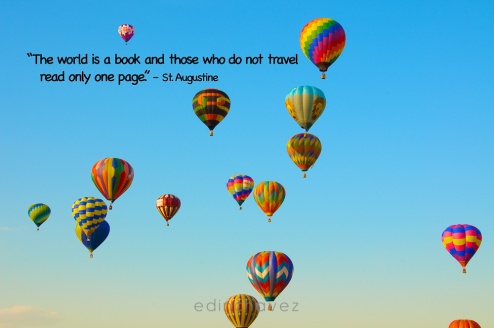Growing up in Iowa, I developed an insatiable desire to see the broader world around me. I would look through binoculars over the cornfield that stretched out behind my backyard, blinking and squinting and imagining the lives of the families living on the other side. At dusk I could see lights go on and off in little window specks. Were there kids inside those windows, making faces as their parents sent them to bed? Did they read the same stories before falling asleep? Those houses felt a world away, but, similar to the worlds inside of books, gave me a hope to one day see what else was outside my little town tucked inside the fields in the heart of America.
I was a quiet kid obsessed with stories. TV shows such as Full House introduced me to big city life as well as big family life, sending me into daydreams of a lifestyle very different from my own. I wondered what it was like to attend a three-story, fenced-in school on a busy city street, to travel by subway, and to grow up living in a high-rise apartment with no yard for dogs or flowers or tomato plants. Anne of Green Gables sent me dreaming of the opposite, of a place where I could be free to wander and roam in the country surrounded by acres of animals, wildflowers, hidden paths, and nothing but time.
I remember when my great aunt Lorraine told me she’d been to all fifty states. I wanted to know if she’d seen the Grand Canyon, the coast of California, the White House. She helped my travel dreams seem attainable, especially since she was someone from my own family.
The Midwest is the perfect place to foster a dream for travel. Especially small town Midwest, where kids grow up curious about the other side of the cornfields. When you have to travel 70 miles for the nearest (substantial) mall, or for the restaurants advertised on TV (Oh the days when The Olive Garden and Chile’s sounded like luxury cuisine), even Starbucks carries with it an extra special appeal. Sipping a mocha Frappuccino during a Saturday shopping trip to Sioux City felt like turning a page in the proverbial book of life experiences—a book with chapters not limited by distance. Every city, every neighborhood has its own character, each street and structure, down to each person.
When I travel I look for the ubiquitous, that little something that helps me connect to the world around me. While acclimating to New Zealand’s summertime in January, I was thankful for the familiarity of the English language. When handling money in Japan I took comfort in the 10 decimal place to know how much I was spending. These connections aren’t to say I didn’t look further, but they did serve as a basis for seeing where I’m from in a new way—whether politically, educationally, by cuisine, or otherwise. When I see how other places function, I question if things here are the best they can be.
A similar outlook is sparked when I read. For example, dystopian literature such as Brave New World, 1984, The Handmaid’s Tale, or The Hunger Games series feature fictional worlds with (quasi) believable futures. If this is where we’re headed, then how can it be prevented?
I believe that when reading and travel are combined, there’s no end to inspiration and understanding. Jack Kerouac’s On the Road inspired me to keep pen and paper with me whenever I leave home. I don’t snap a lot of pictures when I travel but instead rely on words to bring me back to a specific time and place, and to the people I interact with. This is what gives me hope in the modern day world—recording what I see and know and learn—and it’s why I plan to never stop chasing new scenes, in life or in the imagination.

